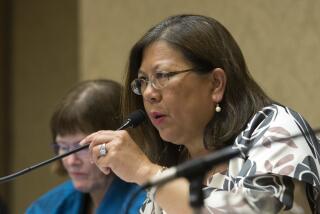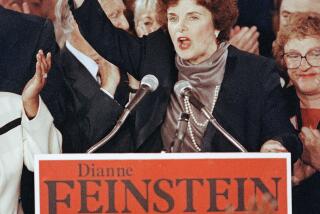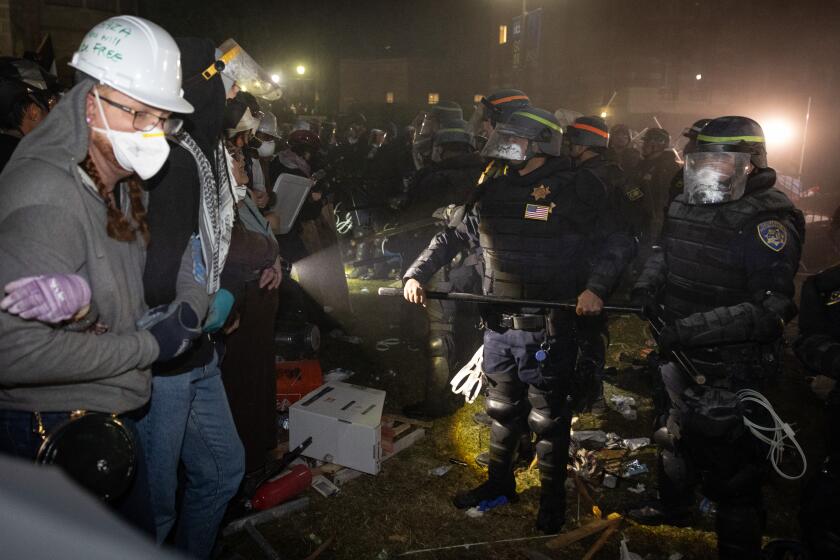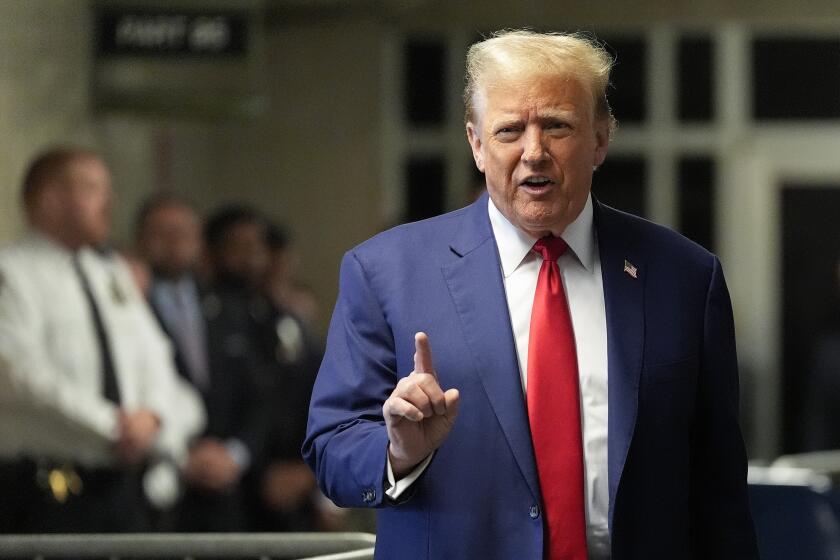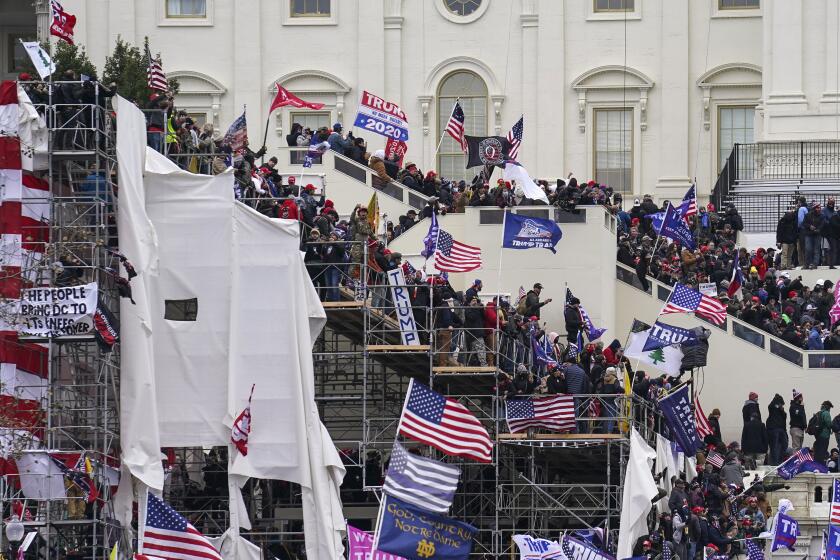COLUMN ONE : To Women, 1992 Could Be <i> the</i> Year : New political dynamics are at work, as races in Illinois and Pennsylvania show. Record numbers of females are running for high office and candidates find fund raising easier.
About midday on Tuesday, when Lynn Yeakel sensed that she had done the amazing and come out of nowhere to win the Democratic nomination for U.S. Senate in Pennsylvania, she called the president of the National Women’s Political Caucus.
“I hope the women will get the credit,” Yeakel told caucus president Harriett Woods. “I feel that women are standing up and making this possible.”
Yeakel was expressing a hope shared by many this election year--that 1992 will become a historic turning point for American women, the year in which they finally begin to significantly increase their numbers in the nation’s councils.
Though they constitute more than half the nation’s population, though they have been a major factor in the economy for decades and though they boast records of achievement in many fields, women have never constituted more than a sprinkling in the Congress, in the governors’ mansions or in the leadership of the two major political parties.
But 1992, because of a unique confluence of circumstances and events, may be a watershed in their long struggle to attain more power in the male-dominated political world, leaders of women’s groups and political analysts say.
Proponents of this vision point to a number of promising signs.
Record numbers of women are already running for high-profile Senate and House seats--67 in California alone. Even more are expected to enter races in states that have yet to choose candidates for Congress now that Yeakel, an obscure fund-raiser for women’s causes, has duplicated the feat of Carol Moseley Braun, an equally little-known Chicago official who last month knocked off veteran Sen. Alan J. Dixon in the Illinois Democratic primary.
Analysts say the November general elections could send as many as five new women to the Senate to join the two now serving amid 98 men. Some think the 28 women representatives in the 435-member House could be increased by as many as 20.
Women also are hoping for substantial gains in state legislatures as they move up from lower offices, which they have been much more successful in attaining in recent years.
Moreover, there is a sense that--in contrast to past balloting patterns--women may be voting increasingly for women.
Efforts to raise money for women candidates also seem to be enjoying greater success, in part because women themselves may be concentrating their giving on women more than in the past.
“We’ve had some good years but I’ve never seen all the pieces of the puzzle come together like they have in 1992,” says Ellen Malcolm, head of Emily’s List, a group that gives “early money” to Democratic women candidates--and is well on its way toward raising three times the $1.5 million it collected in 1990. Most of the group’s funds come from women.
Some veterans of the struggle caution against celebrating prematurely. There have been other election years that seemed bright with the promise of a great political awakening among women but yielded a lean harvest in the fall. Historically, voting patterns among American men and women have rarely diverged significantly, despite all the talk about consciousness-raising and gender gaps.
“I think we’ve been through enough ‘years of the woman’ to be a little cautious,” says Susan Estrich, a USC law professor who directed Democrat Michael S. Dukakis’ 1988 presidential campaign.
Ruth Mandel, director of the Center for the American Woman and Politics at Rutgers University, cautions that it is still too early in the primary season to predict whether all the current excitement will lead to more women victors in November.
Nonetheless, Mandel believes, “if you’re a male incumbent this year, you’ve got a lot to feel nervous about if you’re facing a woman challenger.”
Both Braun and Yeakel say they decided to run after being outraged by the performance of the all-male Senate Judiciary Committee during the Clarence Thomas hearings last fall. Yeakel’s support surged when she aired an ad that focused on the performance of two-term Sen. Arlen Specter (R-Pa.) during the inquiry on Thomas’ nomination to the Supreme Court.
The ad used a film clip of Specter hectoring Anita Faye Hill, the University of Oklahoma law professor who accused Thomas of sexual harassment. Then she asked: “Did this make you as angry as it made me?”
Although polls showed that a majority of Americans believed Thomas’ denial rather than Hill’s charges, activists say the televised hearings galvanized many women. In Illinois, for example, Braun won 42% of those who opposed Thomas--versus 27% for Dixon and 31% for the other candidate in the race, according to an exit poll. And in Pennsylvania, an exit poll showed that Yeakel captured 60% of the voters who opposed Thomas.
Dixon voted to confirm Thomas, as did Specter. But Yeakel’s victory was over two Democratic rivals, not Specter, who scored a strong victory in the GOP primary and may not be easy to beat in November.
Still, activists see Braun’s and Yeakel’s unexpected successes as evidence that the Thomas hearings had an enduring political impact.
So, it is argued, did the highly publicized rape trials of William Kennedy Smith and Mike Tyson. Kennedy was acquitted and Tyson convicted, but both cases are believed to have had a sharp impact on the political feelings of many women.
Analysts say that other key factors also are boosting female candidates this year:
* Women, viewed as the “ultimate outsiders,” are well-positioned to capitalize on an intense anti-incumbent mood widely documented by polls and election results.
* Redistricting and the large number of congressional retirements have created numerous election opportunities because open seats are easier for newcomers to win than those held by well-entrenched incumbents.
* The national agenda has shifted from Cold War concerns to domestic issues, such as jobs, education and health care--issues with which women have long been closely identified.
* The prospect that the Supreme Court will reverse its 1973 decision legalizing abortion has drawn women on both sides of the issue into political activity as the likelihood increases that the battleground will shift from the courts to federal and state legislatures.
So far, 213 women have filed for Senate or House seats this year, contrasting to 171 who ran in the last elections two years ago, according to Federal Election Commission records.
Although the proportion of women to men has improved only slightly--to 11% this year from 10% two years ago--analysts and others believe that women have a better shot at capturing more offices this year because of better candidates and, especially, the changed circumstances.
Women appear to have a chance of taking Senate seats in at least four states besides Pennsylvania and Illinois.
In California, former San Francisco Mayor Dianne Feinstein is seeking the Democratic nomination for one seat and Rep. Barbara Boxer (D-Greenbrae) is vying for the other. Two other women are running under the Peace and Freedom Party banner and a third is running as a Libertarian, though none of the minor party candidates have yet mounted a major campaign.
In New York, two women--1984 Democratic vice presidential nominee Geraldine A. Ferraro and former Democratic Rep. Elizabeth Holtzman--are fighting for the right to challenge Sen. Alfonse M. D’Amato (R-N.Y.).
In North Carolina, former Charlotte Mayor Sue Myrick is a leading Republican candidate to take on Democratic Sen. Terry Sanford.
And in Colorado, Democrat Josie Heath, who lost a bid for an open Senate seat two years ago, is trying for the seat being vacated by Sen. Timothy E. Wirth (D-Colo.). Heath is a former teacher and county commissioner.
California, where retirements and the census-driven creation of seven new House seats have opened many opportunities, could gain as many as four new female congresswomen. The possibilities include Lucille Roybal-Allard and Lynn Dymally, who are seeking to succeed their retiring fathers, Reps. Edward R. Roybal (D-Los Angeles) and Mervyn M. Dymally (D-Compton).
Other prime House candidates include San Mateo County Supervisor Anna Eshoo and three women who are all shooting for the same open seat in coastal Los Angeles: City Councilwoman Joan Milke Flores; Maureen Reagan, daughter of former President Ronald Reagan, and attorney Jane Harmon, an aide to former Sen. John V. Tunney (D-Calif.).
“The Fund for a Feminist Majority mounted a very heavy recruitment drive in California, going district by district to contact businesswomen, officeholders and others to run for Congress and the state Legislature,” says Mary Hughes, a consultant to Eshoo’s campaign. “They did a very good job finding strong women.”
Many female candidates hope for an increase in the willingness of women to vote for women. In Yeakel’s victory Tuesday in Pennsylvania, about 55% of women supported Yeakel in contrast to 40% of men, according to a survey of voters as they left the polls. In Illinois, Braun got a plurality of the women voting in the three-way race--43%, compared to 31% for Dixon and 26% for the other candidate.
Some have observed a related phenomenon: increased financial contributions from women to women.
Jeannie Austin, co-chairwoman of the Republican National Committee, said she believes this change springs from “a changed mind-set.”
Some women activists are tempering their enthusiasm about this year’s prospects.
“I don’t know that we can generalize,” says former Dukakis strategist Estrich. “If Boxer loses, for example, it won’t be because of her sex but because of her checks,” a reference to her 143 overdrafts at the now-defunct House bank. “Feinstein’s big problem is her alleged fund-raising improprieties, not her gender.”
Generally, though, the mood among activists is bright.
“Today is a wonderful day to be a feminist,” Eleanor Smeal, president of Fund for the Feminist Majority, said Wednesday. “Yeakel’s win teaches the lesson. So often, we’ve said (to men): ‘You’ve gone too far.’ And they said: ‘So, what are you going to do about it?’ We didn’t have a way to teach the lesson with a bite in it.
“What is wonderful is that today, they get it. We don’t have to explain anything to anybody.”
Women’s Bid for Power
Primary wins by Carol Moseley Braun and Lynn Yeakel signal what may be an extraordinary year for women in politics.
Candidates for U.S. Congress
Total Women % of women Women in Women in candidates candidates in the field Senate races House races 1992 1,912 213 11% 25 188 1990 1,685 171 10% 12 159
Women running for U.S. Congress from California
Total Senate House 1992 67 5 62 1990 25 * 25
* No U.S. Senate race in 1990.
More to Read
Get the L.A. Times Politics newsletter
Deeply reported insights into legislation, politics and policy from Sacramento, Washington and beyond. In your inbox three times per week.
You may occasionally receive promotional content from the Los Angeles Times.
